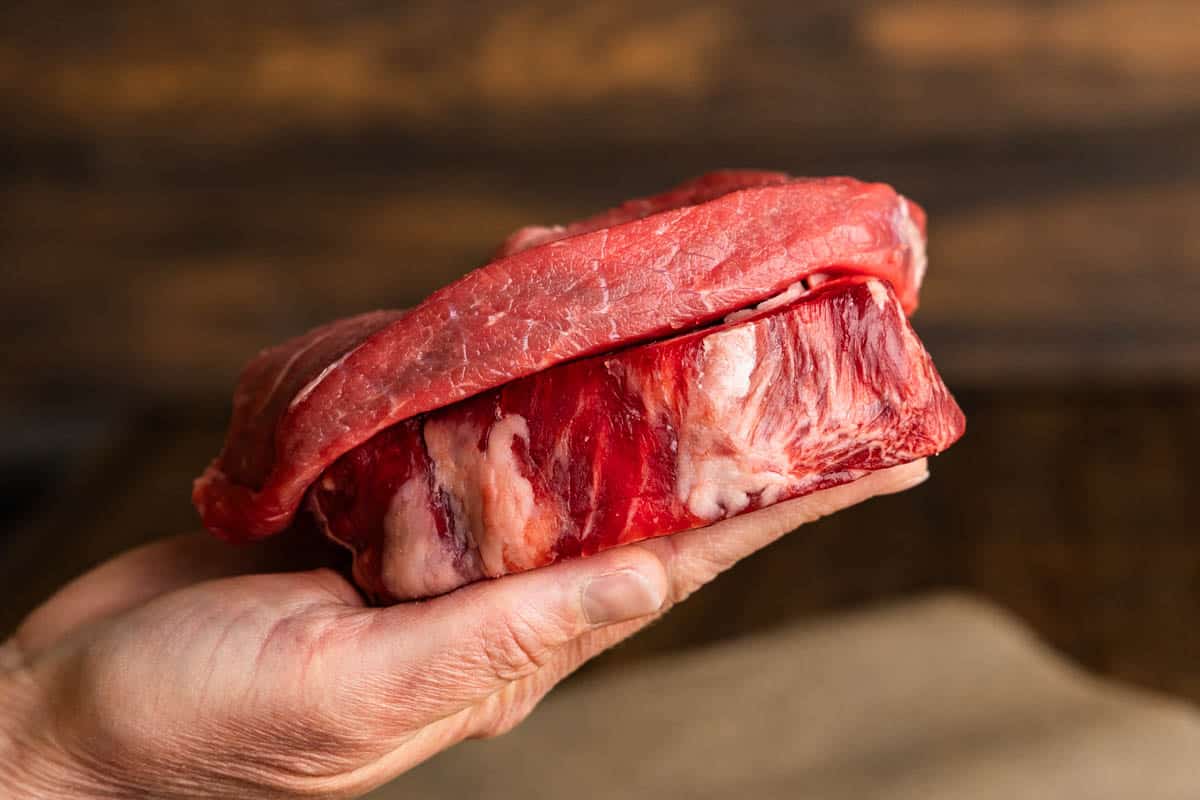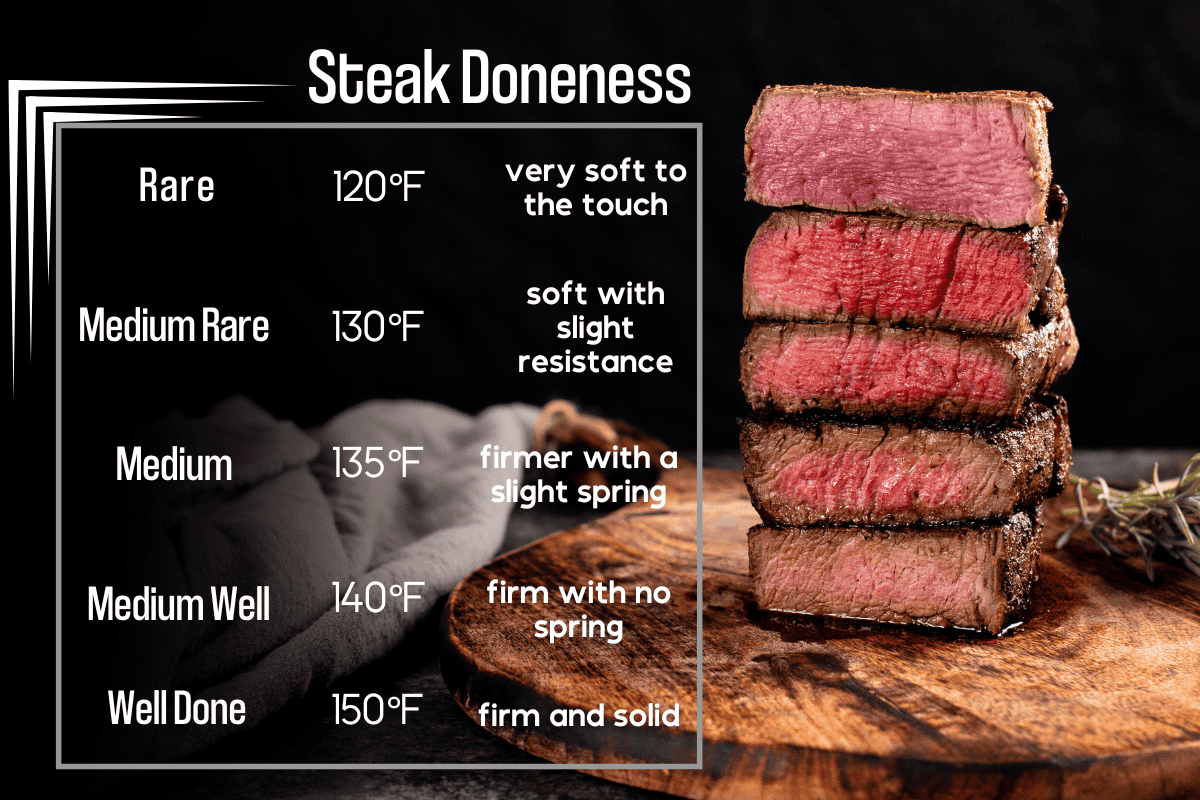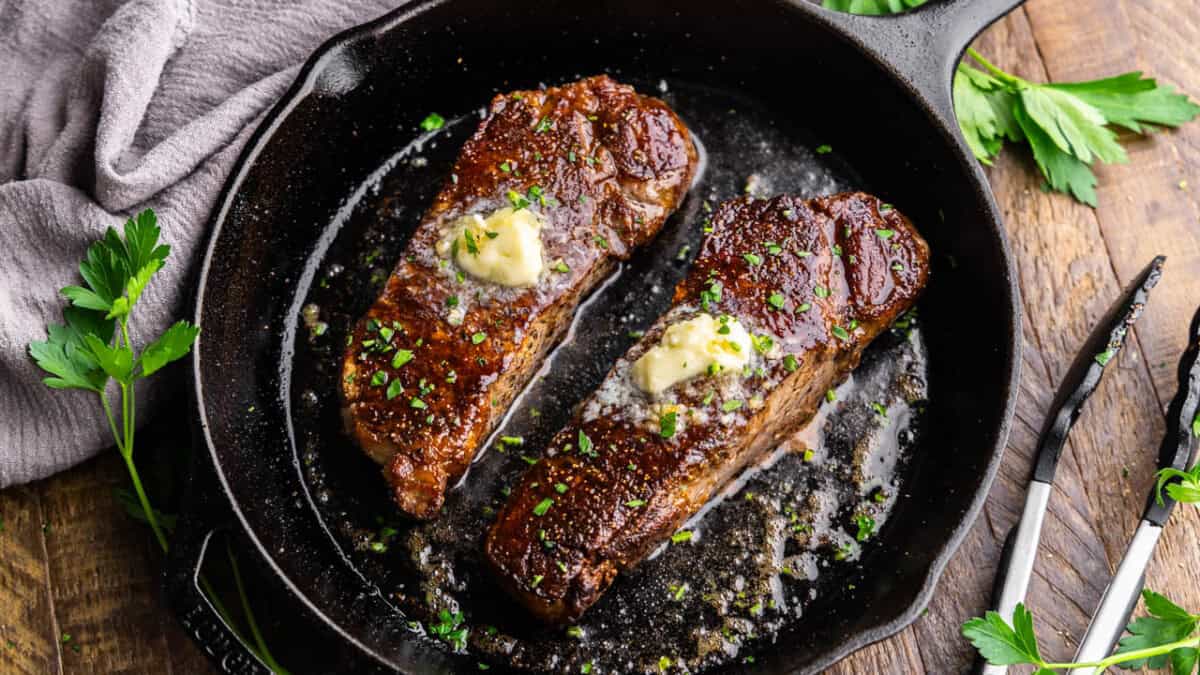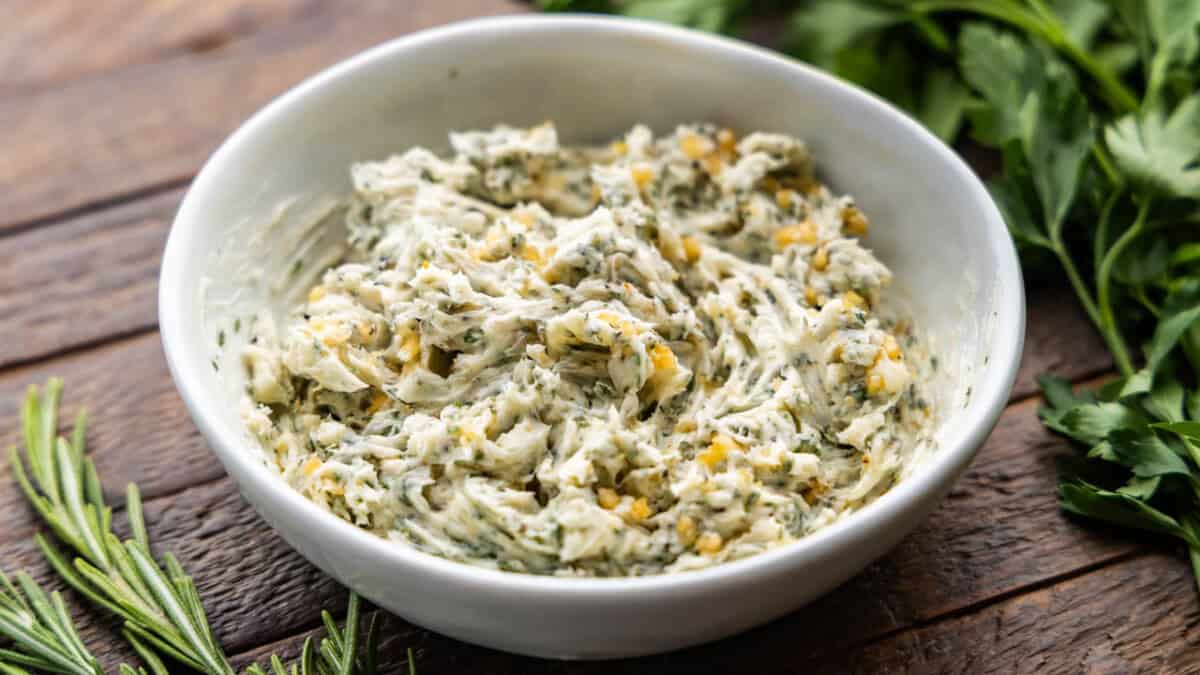This is a detailed guide to cooking steaks, but don’t fret or feel overwhelmed. Our goal is to take the intimidation out of cooking steaks and empower you to be the chef of your own kitchen and wow everyone, including yourself, with a restaurant-quality steak you can easily make at home. Skim the guide to find answers to your questions or read all the way through to become a steak expert.
Why Our Guide
- Straightforward instructions for every part of the process, including a video demonstration.
- Three popular methods: classic stove-to-oven, reverse sear, and butter basting.
- It’s everything you need to know and more, with additional simplified guides for each specific cut of steak.
Cuts of Steak
What cut of steak you make depends on what you like in a steak. There are 5 main steak options, each a little bit different in their texture and tenderness.
Porterhouse and T-Bone
What is it? Porterhouse and T-Bone steaks are similar cuts of beef that come from the short loin. These cuts both have a T-shaped bone in the middle and contain two different pieces of meat: tenderloin and strip steak. Porterhouse steaks are cut from the rear end of the short loin and contain a larger portion of the tenderloin, while T-Bone steaks are cut from the front end and contain a smaller portion of the tenderloin.
Why use it? This steak gives you two different steaks in one! One side is super meaty (the ribeye), the other tender (the tenderloin). The bone in the middle keeps things cooking evenly.
Ribeye and Tomahawks
What is it? Ribeye is a beef steak that is cut from the rib area, between ribs six through twelve. It is a flavorful, marbled piece of beef that yields a very tender result when cooked hot and fast. You can buy both bone-in and boneless ribeye steak. For a giant, popular steak for an impressive feast, you can often find Tomahawk ribeyes with the long rib bone still attached.
Why use it? The marbling of fat in this steak yields a melt-in-your-mouth steak when cooked correctly. The bone-in variety will help the steak cook more evenly. This is a fattier cut of steak that pickier eaters might not appreciate.
New York Strip
What is it? New York Strip steak is a lean cut of beef from the short loin area. It is one side of the porterhouse or T-bone steak and is always served boneless.
Why use it? This is a lean cut of beef steak with little fat. It is an excellent choice for mass appeal.
Top Sirloin
What is it? Top Sirloin comes from the back area continuing off the short loin area. Top sirloin has bones and the bottom round muscles removed.
Why use it? This is a less expensive cut of steak that can still yield a tender and flavorful result. This cut of steak is best suited for marinating and is a more budget-conscious steak option.
Filet Mignon
What is it? Filet mignon comes from the small tip portion of the tenderloin.
Why use it? This is the most tender piece of beef steak and is still quite lean. It is a pricey option, but the resulting melt-in-your-mouth tenderness is unparalleled.
Individual steak guides
Grades of Beef
Beef sold in the United States is evaluated by USDA meat graders who use a combination of subjective assessments and electronic instruments to measure meat characteristics using official grade standards. Beef is graded in two primary ways: quality grades, which assess tenderness, juiciness, and flavor, and yield grades, which measure the amount of usable lean meat.
There are three grades of beef steak that you will commonly find in grocery stores in the United States: Select, Choice, and Prime. These grades help determine the quality of the beef, and grocery stores and butchers will mark the grade on the packaging or display it behind the meat counter. While there is a range of quality within each grade, understanding these basic distinctions can help you make an educated purchase.
- Select Grade: Generally the grade of sale-priced or advertised meats, Select grade is a step above what the USDA deems edible for human consumption. This grade is very uniform in quality and typically leaner than the higher grades. Select beef is fairly tender but may lack some of the juiciness and flavor found in higher grades due to less marbling. Select grades of beef steaks often benefit from marinades and can also be upgraded by using a resting butter.
- Choice Grade: This mid-level grade of beef is ideal for a quality steak made at home, and is often what you find in a Steakhouse. Choice beef is high quality, with less marbling than Prime but still plenty to ensure tenderness, juiciness, and flavor. In our opinion, it’s always worth paying the extra money per pound for Choice grade. If you’re making a steak, make it a nice one—it will still be less expensive than ordering one in a restaurant.
- Prime Grade: Produced from young, well-fed beef cattle, Prime grade beef has abundant marbling (the amount of fat interspersed with lean meat). While restaurants aren’t required to disclose what grade of beef they use, Prime grades are often specifically noted on the menu. Not every grocery store carries Prime grades of steak, but you can often find them in high-end grocery stores. They are easiest to find in actual butcher shops. Prime offers the best in tenderness, juiciness, and flavor, making them the top choice for a premium steak experience at home, but they do cost significantly more.
- Additionally, there are Standard and Commercial grades, which are often sold as ungraded or store-brand meat, and Utility, Cutter, and Canner grades, which are rarely sold at retail but are used to make ground beef and processed products.
Buy Choice or Prime Grade steaks for best results.

Thickness
The thickness of your steak matters. Thick steaks cook more evenly, are more juicy, and are much easier to work with. Aim for a steak that is at least 1-inch thick. A thicker cut gives you more control over achieving the perfect sear without overcooking the inside. It also provides more time for the flavors to develop. Thinner steaks, on the other hand, are more prone to drying out and can quickly become overcooked, making them less forgiving for achieving the ideal doneness. By choosing steaks that are at least 1-inch thick, you can enjoy a more flavorful, tender, and juicy dining experience.
Bone-in vs Boneless
There is an endless debate amongst foodies about whether steaks are better bone-in or boneless, or whether or not it matters at all. Those who advocate for bone-in say that the flavorful marrow from the bone will seep into your meat while cooking, giving you a more flavorful result.
What everyone can agree on is that bone-in DOES impact the cooking time of your steak. The bone changes the way the heat is distributed while cooking. It actually helps your steak cook more evenly and gives you a little more leeway with overcooking. Bone-in steaks will require a longer cooking time because the bone insulates the meat surrounding it. It takes a little more time for the heat to penetrate the interior, but once it does it spreads out evenly.
tl;dr Purchasing Guide
- Buy choice or prime grades of steak for best results. It’s labeled on the package.
- Bone-in or boneless are both great options. Don’t overthink it.
- Definitely buy a thicker steak that’s a minimum of 1-inch in thickness so you don’t dry it out or overcook it.

Steak Doneness
Whether you like your steak practically raw on the plate, or dry as a bone, this steak doneness chart should help you out. The chef’s standard level of doneness is medium-rare. At this point it will be tender, and juicy, and if you do it just right the steak will melt in your mouth. Every steak has a different cooking time due to the varying thicknesses of the cuts.
Instant-Read Thermometers
Using an instant-read thermometer is far and away the best option for ensuring accuracy. It takes the guesswork out of determining doneness, ensuring your steak is cooked exactly to your preference. To use it, simply insert the probe into the thickest part of the steak, avoiding any bones or fat. The thermometer will give an accurate reading in seconds, letting you know if your steak has reached the desired internal temperature. Just try not to poke too many holes in your steak as you’ll notice when you do so that juices run out.
Cooking Steaks By Feel: “The Thumb Test”
Not everyone has an instant-read thermometer and we understand. With time and experience you can learn to judge a steak’s level of doneness by feel alone. We’ll go over “the thumb test”, but just note that it is very difficult to master cooking steaks by touch.
- Rare should feel very soft and yielding. Lightly touch your thumb to your index finger and feel the fleshy area under your thumb. It should feel very soft, similar to the feel of raw meat.
- Medium-Rare should feel soft with a bit of resistance. Lightly touch your thumb to your middle finger and feel the same area under your thumb. It should feel slightly firmer, but still soft.
- Medium should feel firm but with some give. Lightly touch your thumb to your ring finger and feel the area under your thumb. It should feel firmer and more springy.
- Medium-Well should feel firm with very little give. Lightly touch your thumb to your pinky finger and feel the area under your thumb. It should feel quite firm with very little softness.
- Well-Done should feel very firm with no give. Squeeze your thumb to your palm tightly and feel the area under your thumb. It should feel very firm, similar to well-done meat.

Cooking Methods
There are several popular methods for cooking steaks and it’s worth covering all three so you can make an informed decision. We’ve provided instructions for all three in our printable recipe. Here is an initial overview as to what each method is and why you’d use it. These methods work with all cuts of beef steaks and there is not one that is particularly better for any cut of steak.
Stovetop to Oven
This is a standard culinary school method that is the easiest method to follow for any home cook. The steaks start out being seared in a hot skillet and then finish cooking in the oven. This is such a simple, straightforward approach that it’s the one we recommend for those seeking to cook the perfect steak every single time.
Butter Basting
This method is very hands-on, but it’s pretty obvious why one might want to take the time to cook their steak in butter: it’s delicious! Butter basting seeks to maintain the moisture of the steaks through constantly covering them in fat while also infusing them with the flavors of aromatics typically fresh herbs and garlic. This method can get a little tricky to determine doneness and cook your steak evenly
Reverse Sear
This is an increasingly popular method to use, especially for larger quantities of steaks, like catering or cooking for a crowd. The steaks are initially baked at a lower temperature. Once they reach within 10-15 degrees of your target internal temperature for doneness, they are then seared in a hot skillet or on a grill. One of the other major benefits of reverse searing is that this method cooks steaks the most evenly with an even crust.
Grilling
Backyard outdoor grilling is a popular choice because not only does it give steaks an unparalleled smokey fire flavor, it also tends to be a social affair. Eating is meant to be a social affair and when it also involves an open flame, the food just tastes better. We have a separate guide for grilling steaks to help you with some of the more daunting details like using different types of grills and which steaks are most likely to cause flair-ups.
Smoking
Similar to grilling, smoking steak is an increasingly popular choice as pellet grills have become more available and popular. You can find them everywhere nowadays! Smoking uses a low and slow method like the reverse sear, except in this case, the meat absorbs flavorful smoke before being seared. You can learn all about smoking steaks to perfection with this guide to smoked steaks.
tl;dr Cooking Methods
- Stovetop to oven is the easiest and fool-proof method most home cooks can master on the first try.
- Try butter basting if you want to go all out or just use a resting butter for a similar effect without the hassle.
- Reverse sear for the most even cooking and great for cooking for a crowd.
- Grilling and smoking add levels of flavor you can’t get any other way.
Resting Your Steak
When a steak cooks, its juices are pushed towards the center due to the heat. If you cut into the steak immediately after cooking, these juices will spill out, resulting in a drier piece of meat. Allowing the steak to rest for about 5-10 minutes gives the juices time to redistribute evenly throughout the meat. This resting period also allows the fibers in the meat to relax, making the steak more tender and easier to cut.
Resting Butters and Marinades
Marinades on steaks are reserved for the less tender cuts of steaks like sirloin or Select grades of beef. Just because a steak is lower quality or leaner doesn’t mean it can’t still be a great steak. Steak marinades are designed to help tenderize the beef and add flavor.
Resting butters are a type of compound butter that are specifically designed for use with resting meats. The idea is to sandwich your steak in between flavored butter during the resting process. You can use a classic French-inspired compound butter for resting, or use our popular Cowboy Butter for adding some additional smokey, spicy, heat to your steaks.

Resting Butter
10 mins
Level up your meat game to restaurant-quality perfection with our tried and true resting butter recipe from our certified meat expert. Perfect for any meat with a resting time from steaks and pork chops, to chicken and fish. It can easily be made in large quantities and frozen for later use.
That’s it! You should have everything you need to know to cook the perfect steak at home every single time. For a visual reference, watch the video below where Rachel will walk you through every step, showing you how to make a restaurant-quality steak with ease at home.
